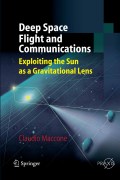
Deep space flight and communications: exploiting the sun as a gravitational lens
Maccone, C.
Part 1 looks at the ways in which it is possible to exploit the focusing effect of the Sun as a gravitational lens for scientific missions to distances of 550 AU and beyond into interstellar space. The author explains the mechanism of the Sun as a gravitational lens, the scientific investigations which may be carried out along the way to a distance of 550 AU (and at the 550 AU sphere itself), the requirements for exiting the Solar System at the highest speed and a range of project ideas for missions entering interstellar space. Part 2 of the book deals with the problems of communicating between an interstellar spaceship and the Earth, especially at very high speeds. Here the author assesses arange of mathematical tools relating to the Karhunen-Loève Transform (KLT) for optimal telecommunications, technical topics that may one day enable humans flying around the Galaxy to keep in contact with the Earth. Provides the reader with an insight into the science and technology of interstellar spaceflight as it is currently envisaged Examines for the first time how it may be possible to exploit the Sun as a gravitational lens for the purposes of interstellar exploration Investigates a key problem of interstellar flight – the telecommunications between the spacecraft and the Earth – especially at very high speeds INDICE: So Much Gain at 550 AU.- Scientific Investigations along the Way to 550 AU.- Magnifying the Nearby Stellar Systems.- Astrodynamics: To Exit the Solar System at the Highest Speed.- SETI and the FOCAL Space Mission.- GL-SETI: Receiving Far ETI Signals Focused by the Gravity of Other Stars.- The Gravitational Lenses of Alpha Centauri A, B, C and of Barnard’s Star.- The Coronal Plasma – ‘Pushing out’ the Focus of the Gravity+Plasma Lens far beyond 550 AU.-NASA’s Interstellar Probe (ISP: 2010 – 2070?) and the Cosmic Microwave Background (CMB).- Interstellar Propulsion by Sunlensing. Pesek Lecture 2003: Innovative Seti by the KLT – an elementary summary of KLT applications.- Brownian Motion, KLT and Time-Rescaling.- Summary: KLT of Time-Rescaled Brownian Motions.- Summary: KLT of Square Time-Rescaled Brownian Motion.- Summary: KLT of B(t2H) and B2 (t2H).- Radio Signals from Relativistic Spaceships in Uniform and Decelerated Motion.
- ISBN: 978-3-540-72942-6
- Editorial: Springer
- Encuadernacion: Cartoné
- Páginas: 500
- Fecha Publicación: 01/04/2008
- Nº Volúmenes: 1
- Idioma: Inglés
